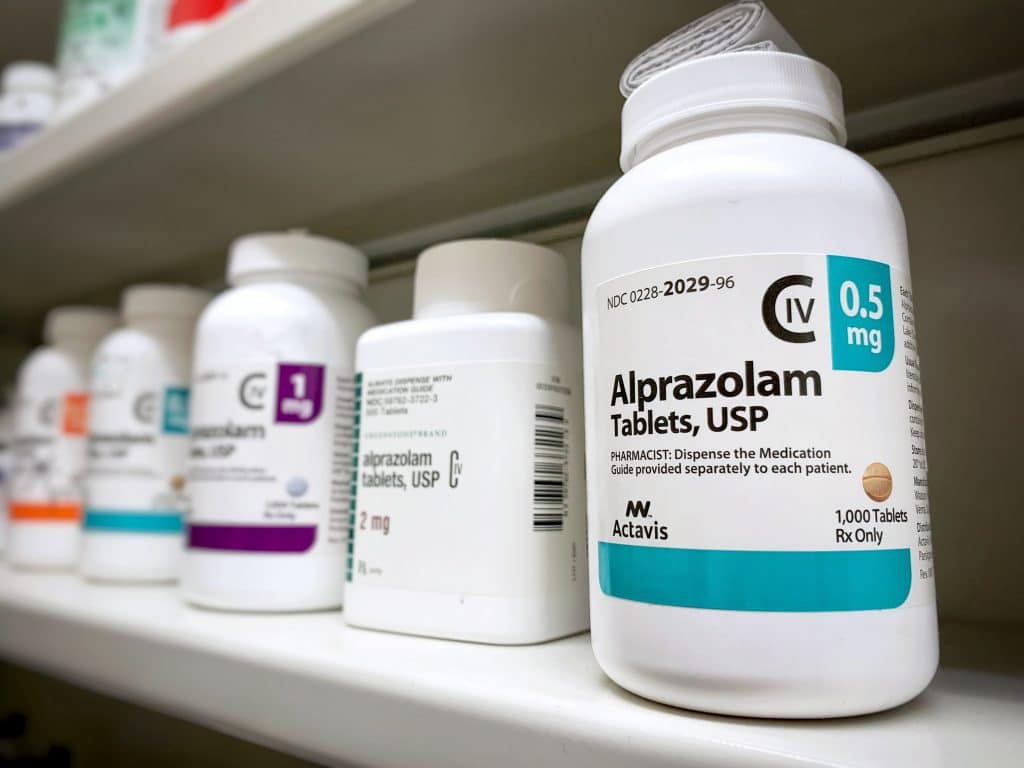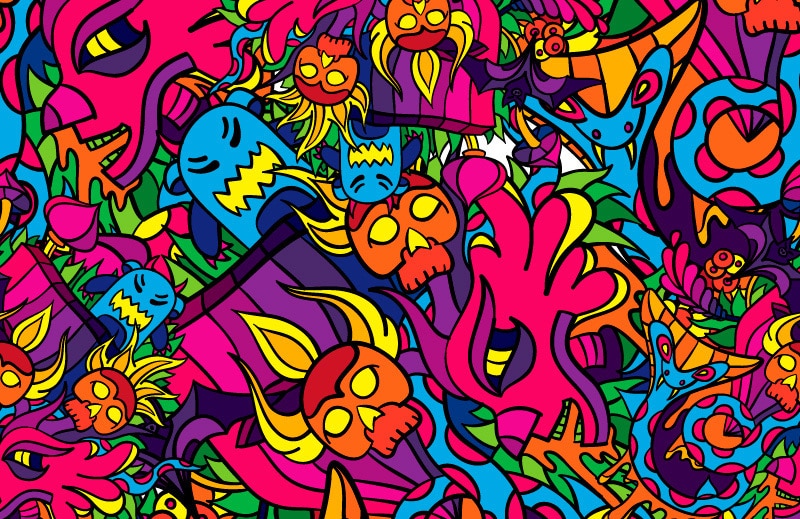Although there typically aren’t many reasons someone would want to stop a trip, having a bad one qualifies. A bad trip can be very intense, and it’s more likely to happen if the user is already nervous or anxious when beginning their drug experience, or if they’re naturally more susceptible to intrusive thoughts and other related mental conditions. Enter Benzos (benzodiazepines), a relatively quick and reliable way to come down or change your trip for the better.
To stay current on everything important happening in the industry, subscribe to The Cannadelics Weekly Newsletter. Also, it’ll get you premium access to deals on cannabis flowers, vapes, edibles, and much more! We’ve also got standout offers on cannabinoids, like HHC-O, Delta 8, Delta 9 THC, Delta-10 THC, THCO, THCV, THCP & HHC, which won’t kill your bank account. Head over to our “Best-of” lists to get these deals, and remember to enjoy responsibly!
What Does it Mean to “Trip” on Psychedelics?
In layman’s terms, a “trip” can be described as a “temporarily altered state of consciousness”. This is an accurate, albeit vague, explanation for something that can be so profound, transcendental, and utterly life-changing. A “temporarily altered state of consciousness” can be achieved through the use of any drug that produces a “high”. Even sleeping, tobacco, and caffeine, will put you in what could be clinically described as a “temporarily altered state of consciousness”.
But psychedelic trips are different in that they are more sentient and thought provoking in nature. Trips often vary in intensity, but they can affect all the senses and can change a person’s thought process, and their sense of time, space and reality. They are known to produce auditory, visual, and sensory hallucinations, however, some users experience no hallucinations at all. Rather, they may feel a sense of general well-being, connectivity, curiosity, and euphoria. Numerous factors make tripping a very subjective experience such as dosing, set and setting, tolerance, among other elements.
Although a psychedelic trip can be reached through meditation, sensory-deprivation, light therapy, and a handful of other methods; the easiest and most common ways to get to this state of mind is through the use of psychedelic drugs. Psychedelic drugs, also referred to entheogens, are a subset of hallucinogens which contain compounds that can alter perception. The term entheogens come from Greek and can be roughly translated to mean “building the God within”.
When we trip, regardless of what causes the trip, the brain reacts in a similar way – with an increased activation of delta and gamma waves and the suppression of alpha and beta waves. When we are awake and alert, the brain is dominated by alpha, beta, and gamma waves. When we sleep, delta and theta waves take over. The pairing of “alert” gamma waves and “sleeping” delta waves, could explain why psychedelics trips are akin to dream-like states that we experience while still awake.
What are Benzodiazepines?
Benzodiazepines, also referred to as “benzos”, are a class of depressant, psychoactive drugs whose core chemical structure consists of a benzene ring and diazepine ring fused together. Benzos are known to lower brain activity by slowing down the rate at which messages travel between the brain and body, which is why they’re commonly used to treat mental health disorders such as anxiety, OCD, insomnia, and seizures – conditions that cause the brain to run on hyperdrive, so to speak.
Benzos are a bit different than other depressant drugs because they also work as mild tranquilizers. In addition to being used for anxiety, it’s believed that benzos can help treat withdrawal from alcohol and other drugs, although this is still a questionable area of study since benzos themselves can be addictive and do have a relatively high potential for recreational abuse. They can also lead to overdoses, especially when combined with alcohol and other narcotics.

Benzodiazepines come in three types: short-acting, intermediate, and long-lasting. Short-acting have a shorter shelf life so they are processed by the body faster, but they are also said to have the worst withdrawal symptoms. Benzodiazepines are known by their chemical (generic) names or their brand names. In each case the drug is the same – it’s just made by a different company. Some common benzodiazepines are: xanax, valium, alepam, murelax, alodorm, and normison.
The Trip Killer
Now, getting to the topic at hand; why are benzos known as “trip killers” in the world of psychedelics? Well, obviously it’s because they have the ability to “kill” or severely diminish your trip. Some people even take benzos to ease the comedown from other drugs, mainly stimulants. But how exactly does it work? Simply put, it all comes back to the way benzodiazepines function as depressants and slow down brain activity.
Not a lot of research is available on this subject, which is expected, but a few small-scale studies have found benzodiazepines to be effective in treating what is known as “LSD toxicity”. According to Medscape, “If placing a patient who has used lysergic acid diethylamide (LSD) in a quiet environment with minimal stimuli is not effective, a benzodiazepine (lorazepam or diazepam) is the medication of choice, especially in patients with dysphoric reactions. Benzodiazepines decrease central and peripheral sympathomimetic drug effects.”
It’s worth noting that results are dose and tolerance-dependent, so the larger the dose of benzos, the less you will eventually feel your trip. For anyone looking to just take the edge off their comedown or turn their bad trip better, about 0.5mg will do the trick. To help you sleep faster, which can be especially challenging after a day or night of tripping, 1mg should be good. To completely kill your trip, you’ll need 2mg or more. A full Xanax bar is 2mg, for reference.
Luckily, it doesn’t take very long for the medication to take effect. For most people, about 15 to 20 minutes (which, if you’re having a bad trip can seem like an eternity) and they will see some changes. Again, in low doses, it kills the psychedelic headspace, so your mind isn’t racing and overthinking, but you still experience some of the physical and visual sensations. For many, the mindset is everything, but I can see how someone who is prone to anxiety, depression, and the like, would benefit from removing the mental aspect from their trip.
Any Non-Pharmaceutical Options?
Taking high doses of benzos to stop a trip completely is one thing, but the idea of using low doses of medication to improve your high, this does beg some questions… the main one being, is it all in our heads? Yes, benzodiazepines will relieve your anxiety, but then again, so will simply convincing yourself that everything is fine. We already know how powerful the mind is in its natural state, but when under the influence of psychedelics you can be much more connected and in-tune with everything around you. Senses and feelings are heightened, and in the same way your mind can quickly put you in a bad trip, if you learn to control it, you can get back into a good trip just as fast.

I stumbled on an interesting story from a Reddit user while I was researching this topic. He states that: “When I have to deal with a naive psychedelic user having a difficult time, I use a technique I’ve heard described. I tell them ‘oh, no, that’s a known thing – you’re having what we call the 15-minutes jitters. It’s an interesting phenomenon, a lot of people experience it, it’s really bad, but it always last 15 minutes, and 15 minutes only. How long has yours been going for? 10 minutes? well, give it 5’ and lo and behold, 5 minutes later, they’re completely fine.”
So basically, the most reliable way (if possible) to get through a bad trip, is by thinking yourself out of it. Of course, the above story could be fabricated, but it is completely plausible. When another Reddit user mentioned that chamomile tea “saved” them when they were “peaking hard and full of anxiety,” another person tactfully replied: “Chamomile tea didn’t do much of anything to help you — what helped you was believing that you had just consumed something that would help you.”
“The best way to reach the other side is to go through the experience,” says Chelsea Rose Pires, the harm-reduction manager and clinical support officer at the psychedelic harm-reduction and education platform Zendo Project. “This can include all the uncomfortable or difficult sensations or feelings that may arise. This doesn’t have to be a bad thing, though.” Pires says a bad trip has the potential to “offer meaningful insight and understanding about our lives,” and adds that “our biggest growth comes through challenging times.”
That said, there are a few palpable things you could do to help you return to a calm and collected state if your trip gets out of hand. First and foremost, it’s important to stay hydrated, no matter what substance you’re on or what you’re doing. Additionally, try having some snacks on hand, talking to a trusted friend, listening to music, going for a walk, or taking a shower. Sometimes, all it takes is a change of scenery to get back in the right headspace.
Final Thoughts
Using benzos to get out of a bad trip is not something I have ever tried myself. Personally, I’m not too big on mixing drugs unless it’s cannabis – weed works with everything. But it’s something I’ve been hearing more about lately from friends and others in the industry, and it’s certainly some knowledge you’ll want to have in your pocket if you’re susceptible to anxious or intrusive thoughts and your trip starts to go south.
Welcome all! Thanks for dropping by Cannadelics.com, a top offering for comprehensive news covering the burgeoning cannabis and psychedelics industries. Stop by daily for a dose of news on these dynamically changing fields, and sign up for The Cannadelics Weekly Newsletter, so you’re up on everything important going on.









